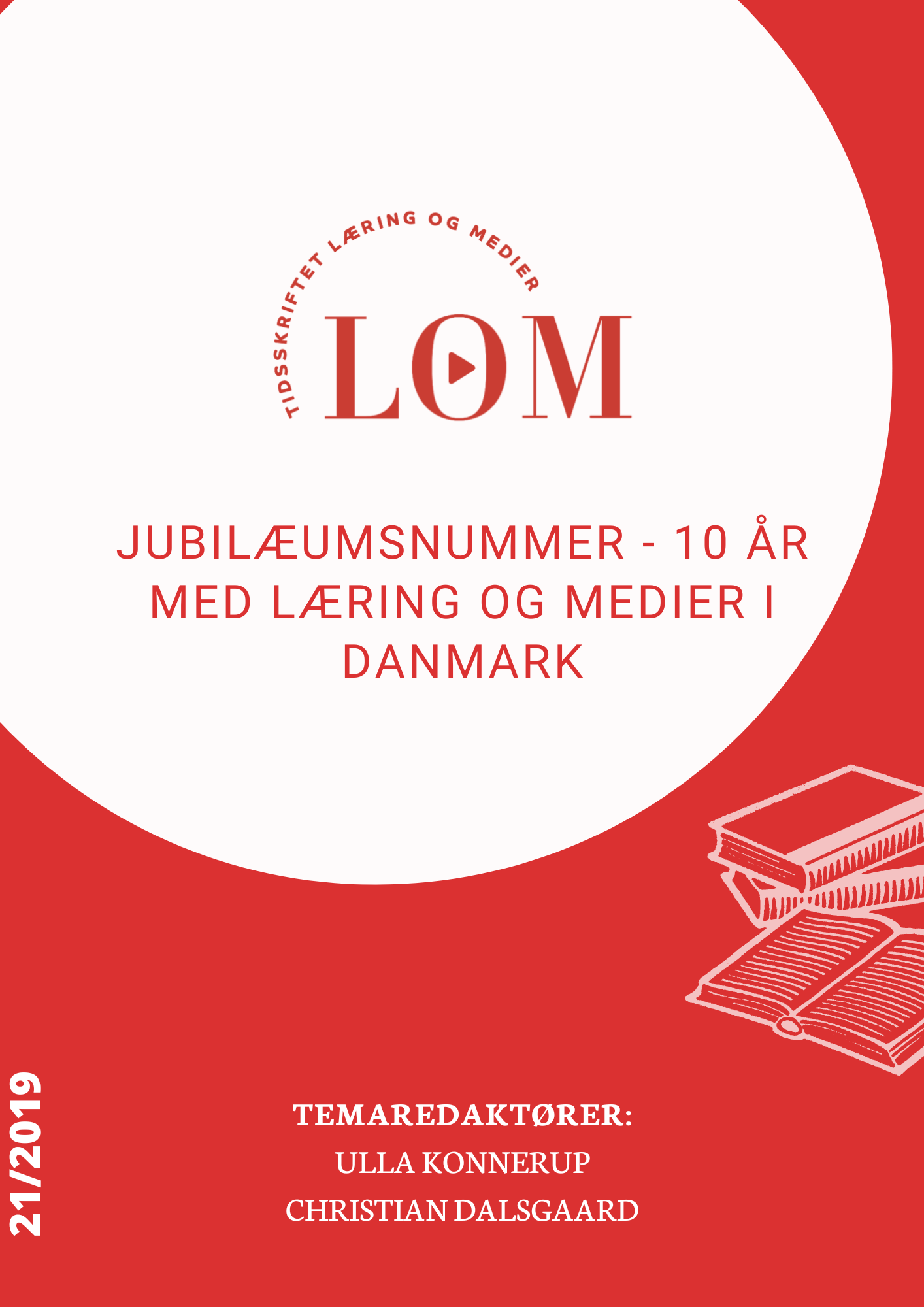The Emerging Landscape of Virtual Environments
DOI:
https://doi.org/10.7146/lom.v12i21.113087Abstract
This paper aims to give an overview of key research on the emerging landscape of virtual environments by identifying selected contributions to the field. Focusing on learning potential and issues, this study describes and discusses how virtual environments change educational practices. Papers selected from the journal Læring og Medier, in conjunction with the publication’s 10th anniversary, form the basis of an overview of how Second Life has contributed to knowledge in a Danish educational context. Second Life’s potential for immersion, presence and embodiment are illustrated by the results of one case from Aalborg University. Finally, this paper predicts how virtual environments might change learning practices in the future.
Downloads
References
Bainbridge, W. S. (2007). The Scientific Research Potential of Virtual Worlds. Science, 317(5837), 472–476. https://doi.org/10.1126/science.1146930
Baym, N. K. (2010). Personal connections in the digital age. Polity Pr.
Blascovich, J., & Bailenson, J. (2011). Infinite Reality: Avatars, Eternal Life, New Worlds, and the Dawn of the Virtual Revolution. HarperCollins. Retrieved from internal-pdf://0.0.4.120/B000APBY5K.html
Blascovich, J., Loomis, J., Beall, A. C., Swinth, K. R., Hoyt, C. L., & Bailenson, J. N. (2002). Immersive virtual environment technology as a methodological tool for social psychology. Psychological Inquiry, 13(2), 103–124.
Blok, R., & Christensen, I.-M. F. (2017). Læringspotentialet i virtuelle verdener. Tidsskriftet Læring Og Medier (LOM), 2(3), 1–6. https://doi.org/10.7146/lom.v2i3.3958
Bryman, A. (2016). Social research methods Bryman. OXFORD University Press (Fifth). Oxford: Oxford University Press. https://doi.org/10.1017/CBO9781107415324.004
Buhl, M., & Rahn, A. (2015). Augmented Reality som wearable. Læring & Medier (LOM), (14), 1–24.
Carr, P., & Pond, G. (2007). The unofficial tourists’ guide to Second Life. St. Martin’s Griffin.
Christensen, I. F. (2009). Turen går til Second Life. Læring Og Medier, (3), 1–32.
Dahl, M. R., Hedegaard, E. R., & Lektor, P. M. (2013). Online farmakologi. Læring & Medier (LOM), (11), 11–2013. Retrieved from http://www.lom.dk
Dean, E., Cook, S., Keating, M., & Murphy, J. (2009). Does this avatar make me look fat? Obesity and interviewing in Second Life. Journal For Virtual Worlds Research, 2(2).
Gibson, W. (1995). Neuromancer. 1984. New York: Ace.
Heilesen, S. (2009). Rum, rammer og biblioteker i den virtuelle verden. Tidsskriftet Læring Og Medier (LOM), (3), 1–26. https://doi.org/10.7146/lom.v2i3.3919
Lave, J., & Wenger, E. (1991). Situated learning: Legitimate peripheral participation. Cambridge university press.
Lindberg, Y. (2009). Verklig fiktion om virtuell verklighet – Litteraturundervisningens utmaning. Tidsskriftet Læring Og Medier (LOM), 2(3). https://doi.org/10.7146/lom.v2i3.3920
Majgaard, G., & Larsen, L. J. (2017). Pokémon GO: A pervasive game and learning community. Proceedings of the 11th European Conference on Games Based Learning, ECGBL 2017, (October 2017), 402–409. Retrieved from https://www.scopus.com/inward/record.uri?eid=2-s2.0-85036461873&partnerID=40&md5=a56ead6ad8faf6c3e9b39a6522562110
Pertaub, D. P., Slater, M., & Barker, C. (2002). An experiment on public speaking anxiety in response to three different types of virtual audience. Presence: Teleoperators & Virtual Environments, 11(1), 68–78.
Rasmussen, Z. L., & Hauschildt, L. (2009). CaseConnexion. Læring & Medier (LOM), (3), 1–18.
Rheingold, H. (2012). Net smart: How to thrive online. Mit Press.
Riis, M. (2010). Mon Wenger har en avatar ? Læring & Medier (LOM), (5), 1–31.
Rudloff, M. (2013). MedieKultur : Journal of Media and Communication Research. Journal of Media and Communication Research, 29(54), 22-P., 29 (54), 22. Retrieved from https://doaj.org/article/cfa5ab5f27c54bbbbc665fed0f580b82
Sanchez-Vives, M. V, & Slater, M. (2005). From presence to consciousness through virtual reality. Nature Reviews Neuroscience, 6(4), 332–339.
Schroeder, R. (2010). Being There Together: Social Interaction in Shared Virtual Environments: Social Interaction in Shared Virtual Environments. Oxford University Press, USA.
Second Life. (2015). In Wikipedia, the free encyclopedia. Retrieved from http://en.wikipedia.org/w/index.php?title=Second_Life&oldid=653591747
Slater, M., Usoh, M., & Steed, A. (1994). Depth of presence in virtual environments. Presence-Teleoperators and Virtual Environments, 3(2), 130–144.
Slater, M., & Wilbur, S. (1997). A framework for immersive virtual environments (FIVE): Speculations on the role of presence in virtual environments. Presence: Teleoperators and Virtual Environments, 6(6), 603–616.
Wenger, E. (1999). Communities of Practice: Learning, Meaning, and Identity (1st ed.). Cambridge University Press.
Wiese, L. (2009). De virtuelle verdeners læringspotentiale. Læring & Medier (LOM), (3), 1–30.
Yee, N., & Bailenson, J. (2007). The Proteus effect: The effect of transformed self‐representation on behavior. Human Communication Research, 33(3), 271–290.
Downloads
Published
How to Cite
Issue
Section
License

Articles published in the Journal of Learning and Media are licensed under a Creative Commons Attribution-NonCommercial-NoDerivatives 3.0 Unported Licens.
Authors retain copyright and grant the journal right of first publication; simultaneously articles are licensend under the Creative Commons Attribution license: Attribution-NonCommercial-NoDerviatives (by-nc-nd). Read about this license at https://creativecommons.org/licenses/by-nc-nd/3.0/
---
At LOM.dk, you will also find articles from the discontinued Journal for the Continuing and Further Education of the Danish Universities (UNEV). Note that special rules apply to UNEV articles:
It is the authors and any other copyright holder who have the copyright of articles published under the auspices of UNEV, and access to the articles is contingent on users acknowledging and complying with the associated legal guidelines:
- Users may download and print one copy of any UNEV publication for private studies or research.
- The redistribution of articles or the use of these for revenue-funded activities or commercial purposes are not allowed.
- It is not allowed to distribute the URLs of UNEV articles.


